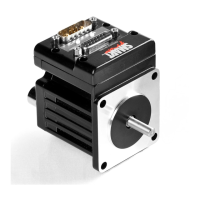Moog Animatics SmartMotor™ Developer's Guide,Rev. L
Page 112 of 909
Combitronic Features
l
127 addressable nodes
l
1 Mbps over the CAN bus
l
No master required
l
No scan list or node list set up required
l
All nodes have full read/write access to all other nodes
Other Combitronic Benefits
Combitronic technology provides a simple way to create a true parallel-processing
environment.
l
PLCs (Programmable Logic Controllers) can be eliminated, due to the speed of program
execution within the SmartMotor, combined with the speed of the Combitronic
communications and the power of the SmartMotor's programming language.
l
Sensors and valves can be connected to the closest SmartMotor in the machine and be
available to the program of any SmartMotor on the network.
l
An HMI (Human Machine Interface) can connect to any one or more of the SmartMotor's
RS-232 or RS-485 ports and provide visibility into the entire network.
l
The size and complexity of the machine collapses to the point where, in many cases,
there is no longer even a cabinet.
As a result, the machine builder is spared the traditional bulk, failure modes, wiring time and
complexity, and costs of separate servo controllers, servo amplifiers and PLCs.
Program Loops with Combitronic
Keep in mind that while Combitronic communications are very fast, program execution is also
very fast. Therefore, if a tight loop is written with a Combitronic transaction inside, you will
flood the CAN bus with data, which can slow the operations of all SmartMotors on the chain.
CAUTION: Tight loops with Combitronic commands can flood the CAN bus
with data and impair the function of a SmartMotor network. For the best
performance, structure programs to minimize disturbance of the CAN
infrastructure.
This problem can be avoided. For example, if motor 1 needs to poll the state of an input on
motor 2, then instead of writing a tight loop with a Combitronic command in it:
1.
Write a tight loop in motor 2 that executes a Combitronic transmission only when that
input changes state.
2.
Issue a Combitronic command in motor 2 that sets a variable in motor 1 in the event of
the input state change.
3.
Program motor 1 to poll its own internal variable.
This way, the actual polling activity is not occupying the CAN bus.
NOTE: A key to powerful programing in SmartMotors is to exploit parallel
processing for throughput without unnecessary polling over the Combitronic
interface, which needlessly wastes throughput.
Part 1: Programming: Combitronic Features

